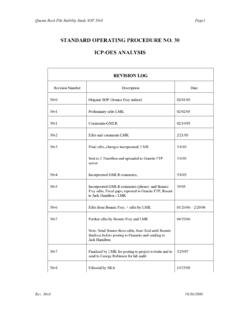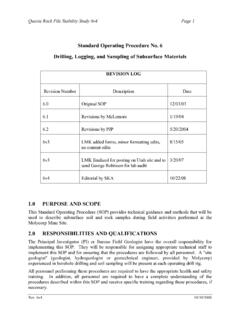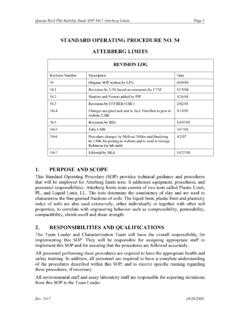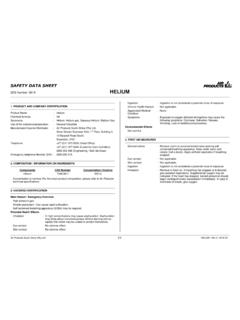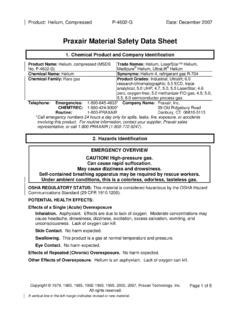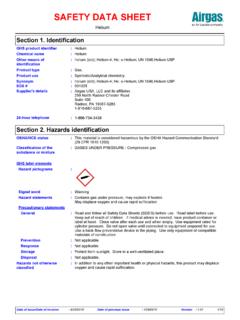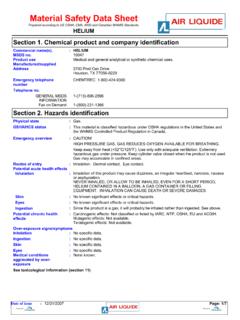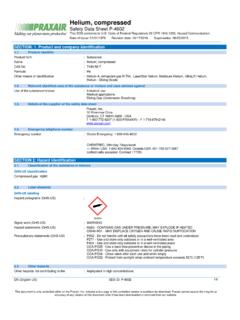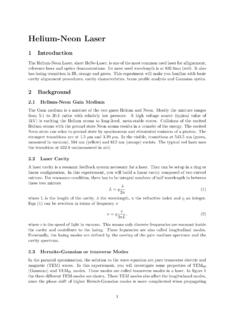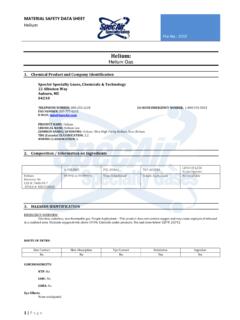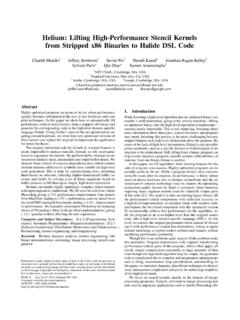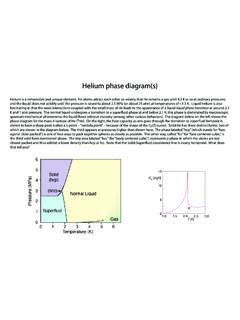Transcription of Open-file Report 483: Helium in New Mexico: Geologic ...
1 Helium in New Mexico: Geologic Distribution and Exploration Possibilities By Ronald F. Broadhead and Lewis Gillard New Mexico Bureau of Geology and Mineral Resources a Division of New Mexico Tech Open File Report No. 483 New Mexico Bureau of Geology and Mineral Resources A Division of New Mexico Tech Socorro, NM 87801 Dr. Peter A. Scholle, Director December 2004 Work performed in cooperation with the New Mexico State Land Office The Honorable Patrick H. Lyons, Commissioner of Public Lands Abstract Helium gas has been produced in New Mexico since 1943. Production has been from eight oil and gas fields located on the Four Corners Platform of northwestern New Mexico. Almost 950 MMCF Helium have been produced from reservoirs of Permian, Pennsylvanian, Mississippian, and Devonian age on the Four Corners Platform in San Juan County In northwest New Mexico, elevated levels of Helium in natural gases occur not only in Paleozoic reservoirs on the Four Corners Platform but also in Paleozoic reservoirs in the deeper parts of the San Juan Basin located east of the Four Corners Platform.
2 The regional set of orthogonal faults that offset Precambrian basement throughout the deeper parts of the San Juan Basin may have acted as migration pathways that transmitted Helium from its basement source into overlying Paleozoic reservoirs. Helium has not been extracted from produced gases in the New Mexico part of the Permian Basin where the concentration of Helium in most reservoir gases is significantly less than percent. However, gases with Helium contents ranging from to almost percent occur in Pennsylvanian and Permian reservoirs along the northwest flank of the basin. The Helium originated by radiogenic decay of uranium and thorium in Precambrian granitic rocks and migrated vertically into Pennsylvanian and Permian reservoirs through regional, high-angle, strike-slip faults.
3 Known accumulations of Helium -rich gases are located near these faults. In this area, lower and middle Paleozoic strata are only a few hundred feet thick, resulting in short vertical migration distances between the Precambrian source and Helium -bearing reservoirs. Other basins and areas in New Mexico are characterized by Helium -rich gases and are of significant exploratory interest. These areas include the Chupadera Mesa region of eastern Socorro and western Lincoln Counties in the central part of the state, the Tucumcari Basin in the east-central part of the state, and a wide region across Catron and southern Cibola Counties in the west-central part of the state. Elevated levels of Helium are found in Pennsylvanian and Permian gases in these areas.
4 2 Introduction Helium is a common constituent of natural gases. It is believed to occur trace amounts in all natural gases (Tongish, 1980). More than one-half of all natural gases contain less than mole percent Helium (Table 1). Only percent of all natural gases in the contain more than mole percent Helium . In general, gases with Helium contents of more than percent are considered to be of commercial interest as Helium sources. Table 1. Distribution of Helium -bearing natural gas reservoirs in United State by Helium content of gases. Data from Tongish (1980). Helium content of reservoir gas, mole percent Percent of reservoirs in Helium -content range < > A very few reservoirs have gases with more than 7 percent Helium .
5 In New Mexico, known (that is, discovered) reservoirs with more than seven percent Helium are confined to the Four Corners platform in the extreme northwest part of the state. The content of hydrocarbon gases in most of these reservoirs is less than 20 percent; most of the non- Helium fraction of the reservoir gas is nitrogen. Although gas has been produced from these New Mexico reservoirs for the Helium they contain, most of the Helium produced in the United States is obtained from reservoirs with less than 1 percent Helium in their gases. Six natural gas reservoirs contain an estimated 97 percent of all identified Helium reserves in the United States (Pacheco, 2002; Table 2). The reservoirs listed in Table 2 have also been produced for their hydrocarbons, which constitute the largest component of the reservoir gas.
6 The senior author of this Report prepared the database, the maps and the written text. The junior author digitized the maps and prepared the GIS projects. The data and ideas expressed in this Report are the responsibility of the senior author. 3 Table 2. The six natural gas reservoirs that contain 97 percent of identified Helium reserves in the United States. Data from Pacheco (2002) and Parham and Campbell (1993). Reservoir State Helium content of gas Mole percent Hugoton Kansas, Oklahoma, Texas Panoma Kansas Keyes Oklahoma Not available Panhandle West Texas Not available Riley Ridge area Wyoming Not available Cliffside TX He-storage reservoir Purpose The purpose of this Report is to provide basic Geologic information pertinent to Helium exploration and prospecting in New Mexico.
7 This Report is meant to provide the user with a useful source of Geologic data and information for those involved with Helium exploration and is also meant to provide an introduction to the Geologic principles of Helium occurrence. This Report contains three major parts. The first part of this Report is this pdf document that presents key Geologic data, maps, and analyses of Helium distribution in New Mexico and summarizes Helium geology. The second part of this Report is a database of natural gas analyses (The New Mexico Helium Database; ) and includes parameters such as well location, sample depth, reservoir stratigraphy, and a variety of data on gas composition including Helium , carbon dioxide, nitrogen, and hydrocarbon content of analyzed gases.
8 The third part of this Report is a series of Geographic Information System (GIS) maps of key parameters useful in Helium assessments. The GIS maps are presented in ArcReader, ArcMap, and pdf formats. Portions of the maps are also presented statically as part of this pdf document, but the GIS portrayal allows the user to overlay the maps on top of each other. ArcReader is a free program made available by ESRI Corp. that allows the user to view maps after the ArcReader software is downloaded from this CD-ROM but does not allow modification of the maps with new data that the user may have; administrator privileges are required to install ArcReader on your computer. For this reason all maps are also presented as an 4 ArcMap project.
9 If the user has ArcMap software then the maps may be modified to accommodate additional data or additional map types may be created from either the well database or from databases the user may supply. The ArcMap files on this computer were created with ArcMap version The GIS maps utilize the data presented in the Helium database as well as structure data presented in this Report . In order to use ArcReader you must have one of the following operating systems installed on your computer: 1) Windows 2000; 2) Windows XP; or 3) Windows NT with Service Pack 6a or later. The GIS maps are also presented in a static pdf format for those who do not with to utilize either ArcReader or ArcMap to view information in map format. Acknowledgments This project was funded by the New Mexico State Land Office (The Honorable Patrick H.
10 Lyons, Commissioner of Public Lands) through contract 04-11 to the New Mexico Institute of Mining and Technology. John Bemis, Tony Nash, Jami Bailey, and Joe Mraz were instrumental in obtaining funding for this project. Joe Mraz acted as project liaison for the State Land Office. As always, the staff of the New Mexico Library of Subsurface Data at the New Mexico Bureau of Geology and Mineral Resources, Amy Trivitt Kracke and Annabelle Lopez, contributed through their meticulous organization of data. Mike Goodman, a student at New Mexico Tech, was most helpful in converting section-township-range locations of wells into latitude-longitude locations. Maureen Wilks graciously programmed the Autorun program that facilitates easy use of the software and information presented on this CD.






